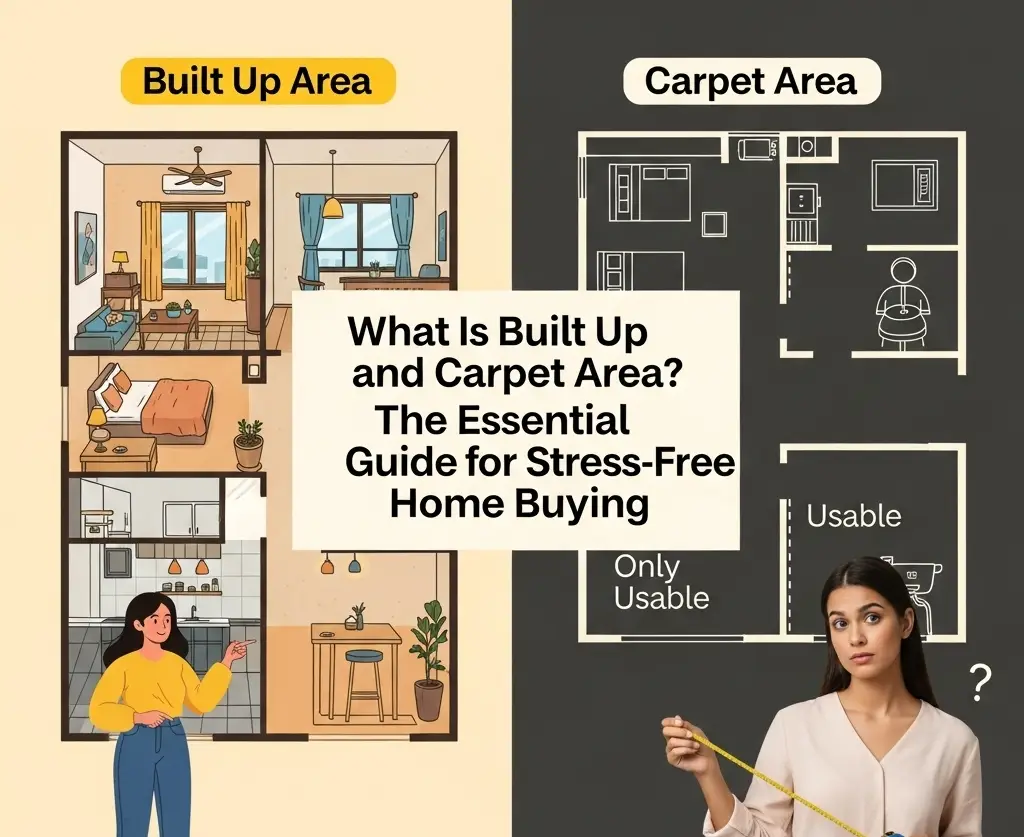Buying a home is one of the most significant decisions you’ll ever make. From comparing locations to evaluating price tags, there’s a lot on your plate. However, one term that confuses almost every homebuyer, especially first-time buyers, is “What is built-up and carpet area?”
It’s crucial to understand this concept to prevent unpleasant surprises later on and ensure you’re getting what you paid for. This blog covers everything you need to know about built-up, carpet, and super built-up areas.
Why This Matters in the Home-Buying Journey
Let’s say you’re shown a 1 BHK flat that’s “650 sq. ft.” But after moving in, it suddenly feels much smaller. Why? Because most of that 650 sq. ft. isn’t your usable space—it includes walls, balconies, and even parts of the lobby or staircase.
That’s why learning about the built-up area and carpet area is not just a technicality—it’s a must for every buyer who wants peace of mind and value for money.
What Is Carpet Area?
The actual usable space in your house is the carpet area. As the name implies, it’s the space inside your apartment’s walls where you can lay a carpet—basically, the area you walk on.
Walls, terraces, balconies, and other communal areas are not included.
Since it indicates the actual size of your living area, this is the most crucial number. For instance, you will be able to decorate and live in a 400-square-foot apartment if that is the actual carpet area.
What Is Built-Up Area?
The built-up area consists of the carpet surface, additional enclosed spaces such as utility areas and balconies, and the thickness of the interior walls.
Therefore, the built-up area of a property is 500 square feet, comprising 400 square feet of carpet area and an additional 100 square feet for the interior walls and balcony. When selling a flat, most builders quote this amount.
Understanding what is built up and carpet area helps you avoid overpaying for unusable space.
What Is a Super Built-Up Area?
Super built-up area, or “marketable area,” is the most difficult of all. This includes your apartment’s built-up area as well as a fair amount of the common areas, such as the clubhouse, elevator area, lobby, stairway, and, in certain situations, the garden.
If the builder claims that the apartment is 700 square feet and extremely built-up, but the carpet area is just 420 square feet, for instance, you are only using 60% of what you paid for.
Key Differences: Carpet Area vs Built-Up Area vs Super Built-Up Area
| Term | Includes | Excludes |
| Carpet Area | Usable rooms, kitchen, bathroom | Walls, balconies, and common areas |
| Built-Up Area | Carpet + walls + balcony | Shared amenities |
| Super Built-Up Area | Built-up + share of common spaces | N/A |

Why Carpet Area Matters the Most to Homebuyers
The carpet area provides the most realistic perspective for determining whether a residence is worth its price. The purpose of the RERA (Real Estate Regulatory Authority) law is to increase transparency in the real estate industry by requiring developers to reveal the carpet area and charge only for it.
When comparing properties, always inquire about the carpet area. You should be aware that two houses with the same “super built-up area” may have somewhat varied carpet areas.
What to Watch Out for When Home Shopping
Builders and agents often advertise super-built-up areas because they sound larger. But as a buyer, your focus should be on the carpet area.
Here’s what to be cautious about:
- Don’t compare prices based on the super built-up area. Always ask for the cost per sq. ft. of carpet area.
- Beware of vague numbers. If a brochure doesn’t mention carpet area, that’s a red flag.
- Understand what’s included in balconies or terraces—some builders add these to inflate built-up areas.
Why These Terms Matter in Navi Mumbai and Other Growing Cities
In fast-developing areas like Navi Mumbai, understanding what is built up and carpet area is even more critical. Builders often market large numbers to attract buyers in a competitive space. But savvy homebuyers know that size isn’t everything—usable space is.
Also, in regions with rapidly increasing real estate rates, even a 50 sq. ft. difference in carpet area can impact your budget by ₹3–4 lakhs.
Use Technology to Simplify the Process
You can use more than just printed brochures and sales pitches in 2025. You can view floor plans, 3D models, and comparisons of carpeted, built-up, and super-built-up areas on various PropTech platforms.
By offering transparent project comparisons, these digital solutions can help you save time and money. Ensure you make an informed choice by using calculators, reputable real estate forums, and websites approved by RERA.
Terms You’ll See on Floor Plans (And What They Mean)
- Carpet Area (CA): Net usable area.
- Built-Up Area (BUA): CA + wall thickness + balcony/utility space.
- Super Built-Up Area (SBUA): Built-up area (BUA) + share in common amenities.
- Loading Factor: The difference between super built-up and carpet area, usually expressed as a percentage.
For instance
If the carpet area is 500 sq. ft. and the super built-up area is 700 sq. ft., the loading is 40%. The lower the loading, the better the value.
Practical Tip for Buyers
When visiting a site, take the floor plan and physically measure a room or two. Often, what’s promised on paper doesn’t match real dimensions. This small effort can save you from future regrets. Also, compare two apartments with similar prices but different carpet areas. More often than not, the one with the larger carpet area offers better value, even if it looks smaller on paper due to a lower super built-up figure.
Final Thoughts
Understanding what is built up and the carpet area gives you the power to see through marketing jargon and focus on what matters—your living space. While built-up and super-built-up regions are commonly quoted, it’s the carpet area that defines your day-to-day comfort, space, and investment value.


Write Your Comment